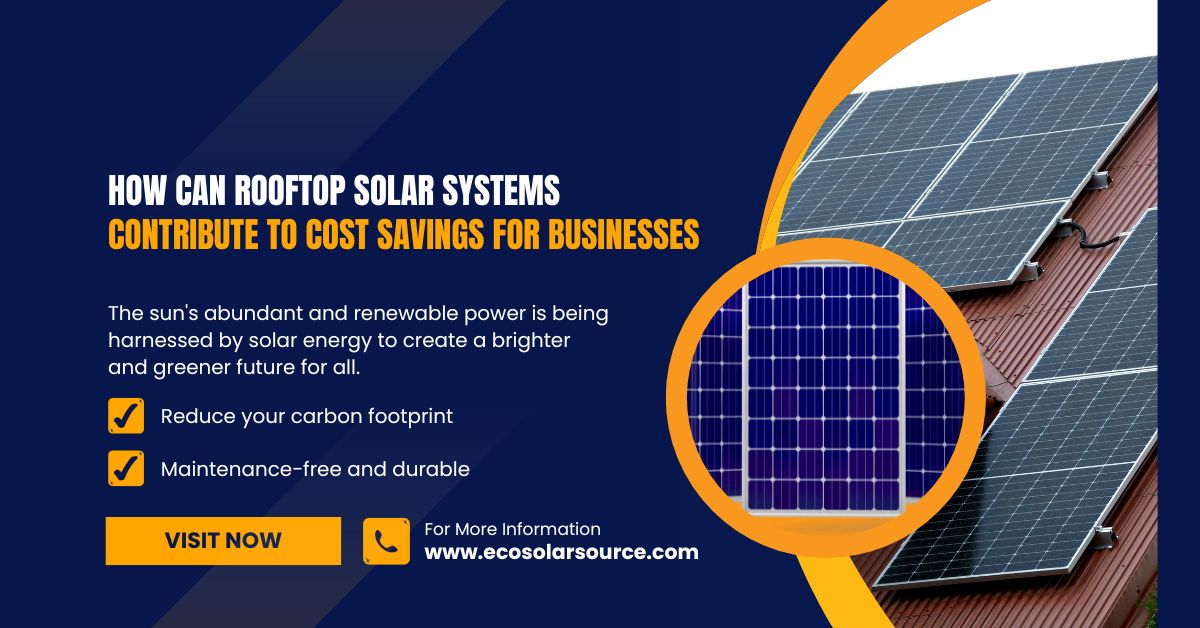How Can Rooftop Solar Systems Contribute to Cost Savings for Businesses
Know the details about How Can Rooftop Solar Systems Contribute to Cost Savings for Businesses, Rooftop solar systems offer substantial cost savings for businesses by generating clean, renewable energy directly on-site, significantly reducing electricity bills. Solar panels harness sunlight, cutting dependency on traditional energy providers, which can lead to lower utility costs, especially during peak hours when rates are highest.
Solar investments also allow businesses to benefit from tax incentives, rebates, and net metering programs, which provide credits for excess energy sent back to the grid. Additionally, solar energy stabilizes long-term energy costs by providing protection against price hikes, creating a more predictable financial environment, and contributing to improved profitability and sustainability.
Table of Contents
How Can Rooftop Solar Systems Contribute to Cost Savings for Businesses
In today’s rapidly changing world, businesses are under increasing pressure to reduce costs while adopting sustainable practices. One of the most efficient ways to achieve both is through the adoption of rooftop solar systems. Solar energy has emerged as a significant player in the renewable energy sector, and companies, both large and small, are turning to solar power to decrease their operational costs and environmental footprint.
Rooftop solar systems, which involve installing photovoltaic (PV) panels on the roof of a commercial building, can generate electricity for on-site use, reduce energy bills, and sometimes even generate revenue through surplus energy sales. But how exactly can businesses save money through rooftop solar? In this article, we’ll explore the financial benefits, incentives, and overall impact that solar energy systems can have on a business’s bottom line.
Reduced Energy Costs
One of the most obvious benefits of rooftop solar systems for businesses is the potential for significantly lower energy bills. Electricity is a major operational cost for most companies, especially in sectors like manufacturing, retail, and data management, where energy consumption is high. Here’s how solar power can reduce those costs:

a. Energy Generation On-Site
- By installing a rooftop solar system, a business can generate its electricity on-site. Solar panels capture sunlight and convert it into electricity through the photovoltaic effect, which can then be used to power the building’s lighting, heating, cooling, machinery, and other equipment.
- This reduces the reliance on grid-supplied electricity, which is subject to fluctuating prices. The cost of electricity from the grid tends to rise over time due to inflation, regulatory changes, and demand. With solar, a business can shield itself from these price hikes by producing a stable and predictable source of energy.
b. Peak Energy Cost Reduction
- Many businesses experience peak energy usage during certain times of the day, particularly in the afternoon when air conditioning systems are working hardest. During these peak times, electricity from the grid can be more expensive.
- Rooftop solar systems, however, generate the most power during daylight hours, which often coincide with these peak usage times. This allows businesses to offset their highest energy consumption with solar power, reducing the amount of expensive peak-hour electricity they need to purchase from the grid.
c. Long-Term Savings
- The initial cost of a rooftop solar installation can be offset over time by savings on electricity bills. Typically, a well-designed system can pay for itself in 5 to 10 years, depending on the size of the installation, the local cost of electricity, and the available incentives.
- After the system has paid for itself, the electricity it generates is essentially free, meaning that a business can enjoy reduced energy costs for the lifespan of the solar panels, which can be 25 years or more.
Tax Incentives and Rebates
Governments around the world are promoting renewable energy by offering a variety of tax incentives and rebates to businesses that install solar power systems. These incentives can significantly reduce the upfront costs of solar installations, making the switch to renewable energy even more financially appealing. Some common types of incentives include:
a. Investment Tax Credit (ITC)
- In many countries, businesses that install solar energy systems can take advantage of the investment tax credit (ITC). This allows them to deduct a percentage of the cost of installing the system from their taxes. In the U.S., for example, the federal ITC allows businesses to deduct 30% of the cost of installing solar from their federal taxes.
- This can dramatically reduce the initial cost of the system, improving the return on investment and shortening the payback period.
b. Depreciation Benefits
- Solar energy systems are considered capital assets, meaning they can be depreciated over time. In some cases, businesses can take advantage of accelerated depreciation programs such as the Modified Accelerated Cost Recovery System (MACRS) in the U.S., which allows businesses to deduct the value of the system over a shorter period (often five years).
- Accelerated depreciation provides immediate financial benefits and reduces the tax liability in the early years of owning the system.
c. Local and State Incentives
- In addition to federal incentives, many states and local governments offer rebates and incentives for businesses that install solar energy systems. These can include cash rebates, additional tax credits, or grants that can further reduce the upfront cost.
- Some utility companies also offer performance-based incentives (PBIs), where businesses receive payments for the amount of solar energy their system produces, based on the number of kilowatt-hours (kWh) generated.
Net Metering and Energy Credits

a. Net Metering
- One of the key financial benefits of rooftop solar systems is the ability to participate in net metering programs. Net metering allows businesses to sell excess electricity generated by their solar system back to the grid. In essence, when a business’s solar system produces more electricity than is being used (such as on weekends or holidays when operations may be reduced), the excess power is fed into the grid, and the business receives a credit on its utility bill.
- These credits can be used to offset future electricity consumption, especially during times when the solar system is not producing enough energy to meet the business’s needs (such as at night or during cloudy weather). This can help businesses further reduce their electricity costs and, in some cases, eliminate their utility bill.
b. Feed-in tariffs (FITs)
- Some countries or regions offer feed-in tariffs, which are payments made to businesses for the electricity they generate and supply to the grid. Feed-in tariffs can provide a steady revenue stream for businesses that generate excess solar energy, helping to further improve the financial returns of the system.
c. Renewable Energy Credits (RECs)
- Businesses that install rooftop solar systems may also be eligible to earn Renewable Energy Credits (RECs). These credits represent the environmental benefits of generating clean energy, and they can be sold to other organizations looking to offset their carbon emissions or meet renewable energy mandates.
- Selling RECs can create an additional revenue stream for businesses, further enhancing the financial benefits of a solar installation.
Reduced Operating and Maintenance Costs
One of the common concerns businesses have when considering a solar energy system is the potential for high operating and maintenance costs. However, rooftop solar systems are generally low-maintenance and have minimal ongoing costs:
a. Low Maintenance Requirements
- Solar panels are designed to be durable and long-lasting, with most systems requiring little maintenance beyond occasional cleaning and inspections. Most solar PV systems come with warranties of 20 to 25 years, and the expected lifespan of the panels is often even longer.
- Routine maintenance typically involves ensuring that the panels are free from debris, dust, and dirt, as well as checking for any issues with wiring or connections. These tasks can often be handled by the solar installer or a local maintenance provider at a relatively low cost.
b. Inverter Replacement
- The inverter, which converts the DC electricity generated by the solar panels into AC electricity for use in the building, is one component that may need to be replaced after 10 to 15 years. However, advances in inverter technology have led to longer lifespans and lower costs for replacements.
- Inverter replacement costs are generally a small fraction of the total system cost, and by the time an inverter needs to be replaced, the savings generated by the system will have far exceeded the cost of replacement.
Increased Property Value
Installing a rooftop solar system can increase the value of a commercial property. Businesses that own their buildings can benefit from higher property values, as solar energy systems are considered a desirable feature by many buyers and tenants. Solar installations provide long-term energy cost savings and demonstrate a commitment to sustainability, making a property more attractive to potential buyers or tenants.
a. Energy Savings Attract Tenants
- For businesses that lease out their buildings or have tenants, a rooftop solar system can be a selling point. Tenants are increasingly seeking energy-efficient spaces, and a solar-powered building offers the benefit of lower energy costs, which can be a significant factor in choosing a location.
- In competitive real estate markets, the presence of solar power can differentiate a property and make it more attractive to eco-conscious businesses looking to reduce their carbon footprint.
b. Higher Sale Prices
- Several studies have shown that properties with solar installations tend to sell for higher prices than comparable properties without solar. Buyers are willing to pay more for a building that has lower operating costs and a built-in renewable energy system.
- This increased property value can benefit businesses that may choose to sell their building in the future, providing a financial return on the solar investment beyond the energy cost savings.
Protection Against Energy Price Volatility
The cost of electricity from traditional fossil fuel sources is subject to volatility due to fluctuating fuel prices, geopolitical factors, and changes in supply and demand. This volatility can make it difficult for businesses to predict and control their energy expenses. Rooftop solar systems offer a hedge against this volatility:

a. Stable and Predictable Energy Costs
- Once a rooftop solar system is installed, the cost of the electricity it generates is essentially fixed. The business can predict its energy costs with greater certainty, allowing for more accurate financial planning and budgeting.
- By reducing or eliminating dependence on grid electricity, businesses can insulate themselves from the price spikes that often occur in the energy market due to factors beyond their control.
b. Long-Term Energy Security
- As the global energy landscape shifts, businesses that rely on traditional energy sources may face increasing costs and potential supply disruptions. By generating their electricity through solar power, businesses can ensure a stable and reliable energy supply.
- This long-term energy security can be particularly valuable for businesses operating in regions with unreliable grids or frequent power outages. Solar energy systems paired with battery storage solutions can provide backup power during grid failures, reducing downtime and maintaining business continuity.
Environmental and Corporate Social Responsibility (CSR) Benefits
Beyond the direct financial benefits, installing a rooftop solar system allows businesses to meet their corporate social responsibility (CSR) goals and improve their environmental impact:
a. Reduced Carbon Footprint
- Solar energy is a clean and renewable source of power, producing no greenhouse gas emissions during operation. By switching to solar, businesses can significantly reduce their carbon footprint and help combat climate change.
- Many customers and stakeholders now prioritize environmental sustainability when choosing which businesses to support. By demonstrating a commitment to reducing emissions, companies can enhance their brand reputation and attract environmentally conscious consumers and partners.
b. Meeting Sustainability Goals
- Many companies have established sustainability goals, such as reducing energy consumption, lowering emissions, or achieving carbon neutrality. Rooftop solar systems provide a tangible way to meet these goals while simultaneously saving money.
- Installing solar power can also help businesses comply with regulations and mandates related to renewable energy usage, as well as qualify for sustainability certifications, such as LEED (Leadership in Energy and Environmental Design).
FAQs About How Can Rooftop Solar Systems Contribute to Cost Savings for Businesses
Q1. How much can a business typically save with a rooftop solar system?
Savings can vary, but businesses may reduce energy costs by 20-50%, depending on system size, energy needs, and local rates.
Q2. What are the main cost components for a business installing a rooftop solar system?
Key costs include solar panels, inverters, installation, permits, and maintenance, though these may be offset by tax credits and incentives.
Q3. How do government incentives and tax breaks contribute to the cost savings of rooftop solar for businesses?
Incentives like Investment Tax Credits (ITC), accelerated depreciation, and rebates can significantly reduce upfront costs, enhancing long-term savings.
Q4. How long does it take for a business to achieve a return on investment (ROI) with rooftop solar?
Most businesses see ROI within 3-7 years, depending on factors like system size, energy consumption, and available incentives.
Q5. Can a rooftop solar system protect a business from rising electricity costs?
Yes, it provides energy independence, mitigating the impact of utility rate increases and reducing reliance on grid power.
Q6. How does net metering add to the cost-saving potential of rooftop solar for businesses?
With net metering, excess energy is fed back to the grid, earning credits that offset costs during times of higher usage or low solar production.
Q7. Can businesses sell excess solar energy back to the grid to boost cost savings?
In many areas, businesses can sell surplus energy, turning their rooftop system into an additional revenue source.
Q8. What is the maintenance cost of rooftop solar systems, and does it impact overall savings?
Maintenance costs are relatively low, with regular cleaning and occasional inspections, so they don’t heavily impact savings.
Q9. Can rooftop solar systems be integrated with energy storage solutions for added savings?
Yes, combining solar with storage allows businesses to use stored energy during peak rates, further reducing costs.
Q10. What are the potential long-term financial benefits of installing a rooftop solar system?
Long-term benefits include stable energy costs, increased property value, potential tax deductions, and an improved corporate image as a green business.
Rooftop solar systems offer businesses a multitude of benefits, ranging from reduced energy costs to enhanced sustainability efforts. By generating clean, renewable energy on-site, businesses can protect themselves against fluctuating energy prices, lower their operational expenses, and take advantage of various financial incentives. Moreover, the environmental and corporate social responsibility benefits further strengthen the business case for solar power.
With the global push toward renewable energy and increasing awareness of environmental issues, now is the perfect time for businesses to consider investing in rooftop solar systems. Not only does it contribute to long-term cost savings, but it also helps companies build a greener, more sustainable future for themselves and their stakeholders.
Click here to learn more about Annual Maintenance Contracts for Solar Systems All You Must Know

